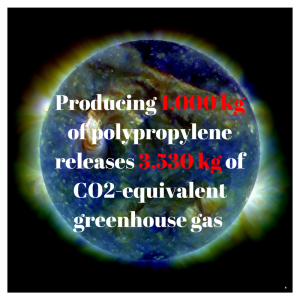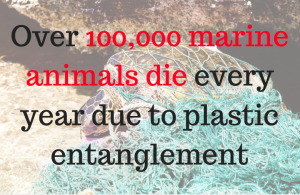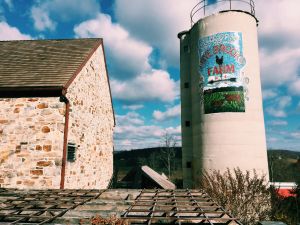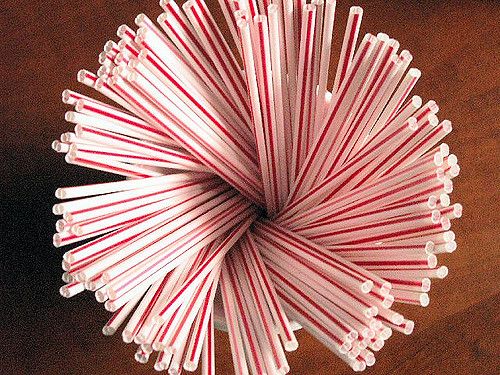Each year the world, as a whole, throws away 2.12 billion tons of waste.
Of that 2.12 billion tons, hardly any of it makes it to a recycling center.
A large contributor to those 2.12 billion tons of waste are straws. In the United States alone, 500 million plastic straws are used and thrown away every single day. Those 500 million straws could wrap around the Earth two and a half times.

Plastic, non-reusable straws are made out of polypropylene– a petroleum-based plastic. Its production calls for fossil fuel extraction, which then affects climate change, subsequently negatively affecting the Earth.
Even though it has been reported that polypropylene is BPA free, that is actually not the case. It has been proven to release synthetic estrogens, a BPA. This release hurts the environment and the wildlife that inhabits it.
And with the exponential amount of straws being put in landfills every day, in the United States alone, it is time to think about the carbon footprint individuals are leaving on Earth.
This plastic straw “epidemic” is not one answered so simply by the mantra: “Reduce, reuse, recycle.”
Rachel O’Brien is a junior at Temple University majoring in environmental studies. O’Brien pointed out that addressing the plastic straw epidemic is not going to be simple, as the suggested alternatives are not necessarily better for the environment.
“Straws, specifically plastic straws, are only recyclable based on what type of recycling is accepted in your area; however, most straws are just thrown in the trash anyway. In both cases, it is more likely to end up in a landfill where it will never biodegrade,” O’Brien said. “Even more ‘environmentally conscious’ straw options, such as paper straws, are often lined with a wax coating and will not biodegrade in a landfill. Landfills are so compacted these days that even things that are technically biodegradable don’t get enough oxygen to break down, so if you see a straw option advertised as ‘biodegradable’ or ‘eco-friendly’, you are being deceived.”
No matter where straws end up, they are hurting our planet, and there are people who see the need for change.
This past summer, Charleston, South Carolina took the straw epidemic into their own hands by starting a campaign called “Strapless Summer Challenge.”

This movement started after the Folly Beach Sweep in May 2017, where over 300 straws were found littering the beaches.
In Charleston County, straws cannot be recycled. That means plastic straws are then dumped into landfills, the ocean and other places. Although small, those plastic straws cause great harm to marine life.
This movement brought over 70 restaurants and bars in the Charleston area to stop using plastic straws.
Leaving straws from the table setting is not something new in the world of protecting the environment.
Chantal Plamondon has dedicated her life and career to removing not only straws but all plastics from people’s lives.
When it comes to plastic straws, Plamondon said, “[They] are particularly destructive single use plastic pollution problem all over the world. They are routinely and unthinkingly automatically given out in restaurants– and often not even used at all. That piece of petroleum-derived plastic goes straight into a landfill; most plastics are not recycled. This is on top of the problem of putting plastic directly in your mouth, in contact with your acidic saliva, which will increase any leaching of chemicals that is already occurring from the plastic.”
Plamondon co-founded Life Without Plastic, a company that provides “safe, high-quality, ethically-sourced, Earth-friendly alternative to plastic products.”
“If you are a straw user, it just makes common sense to invest in a glass or stainless steel straw and carry it around with you, Plamondon said. “And we can all encourage restaurants to switch to reusable straws, or at least to not give out plastic ones unless the customer asks for one.”
Plamondon and the rest of the company are making it their goal to rid the Earth of fossil-fueled plastic and protect the Earth and its wildlife. Her plastic-free journey began in 2003, after the birth of son.
Life Without Plastic offers three different types of sustainable and reusable straws- glass, stainless steel and bamboo.
People are joining the fight left and right, near and far.

Wyebrook Farm, a local farm to table restaurant in Honey Brook, PA, also made the switch from plastic straws to a more environmentally friendly option.
“We made the switch last year after being educated about the over abundance and issue of non-biodegradable straws. I came across a statistic that the current usage of straws in the US could fill 127 school buses each day, or more than 46,400 school buses every year,” General Manager Lauren Heald said. “Being a business that focuses on sustainability and preservation of the planet and it’s resources, we couldn’t continue using plastic straws.”
If more places adopted a no-straw policy, the planet would benefit immensely. But, the journey can begin in the average household as well.
O’Brien shared the steps she’s taken and continues to take every day so that our Earth can stay as healthy as possible.
“Trading in your 24 pack of Poland Spring water bottles for one trendy, reusable water bottle. It could mean thinking ahead and bringing a reusable coffee cup with you in the morning so you don’t have to get a plastic or wax-lined cup– neither of which will biodegrade. You’d be surprised at how many places will gladly fill up a 12 oz or 16 oz coffee cup for you,” O’Brien said. “You also need to educate yourself. Take the time to do your own research about the environment and issues such as waste, ocean pollution, fast fashion, diet based issues, etc. I found a handful of documentaries that helped me to learn about these topics, such as ‘The True Cost,’ ‘Before the Flood,’ ‘Conspiracy,’ ‘A Plastic Ocean’ and many more. I also learned through bloggers like Lauren Singer and Ella Grace Denton who discuss their own methods for living more sustainably.”
When it comes to bettering the environment and doing your part, it does not need to be overwhelming.
“I think it’s important to get past the ‘I’m only one person’ mentality,” O’Brien said. “Each person has the ability to reduce their own impact and educate/influence others in the process. It’s so important to consider your individual decisions and find ways to make your everyday routine more eco-friendly.”



